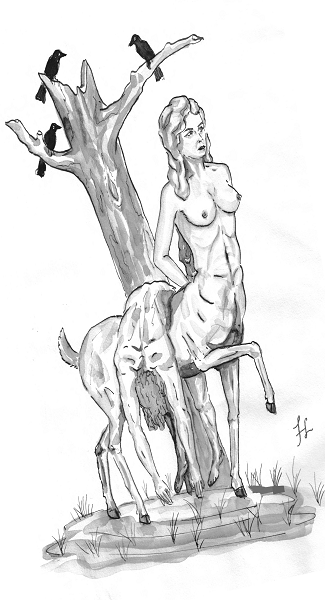

 |
 |
dainefemme: Fallow Doe of The Three Ravens Ballad
|
"To render 'fallow doe' literally presents three problems incapable of
solution: 1) How does the doe get past the knight's hounds?; 2) How does
the doe manage to "lift up his bloudy hed"?; 3) How does the doe manage
to fill the grave (if we assume it already dug)?
. . .
However, if we take 'fallow doe' as a metaphor for a woman
two new problems arise: 1) What is the significance of the epithet?; 2)
The tasks of getting the knight on her back and carrying him to a grave
require a strength which is inconguous with her attributes of tenderness
and loving concern. These problems strongly suggest the need of some
third alternative, and one is readily available; viz, this "fallow doe"
is a centaur-like woman, or to coin a word, a dainefemme(deerwoman),
presumably possessing nymph-like qualities." From The Three Ravens Explicated. |
The Three Ravens Lyrics (pdf)
The Three Ravens Lyrics (html)
The Three Ravens Explicated
(pdf image) also
here
1911
Encyclopedia Britannicaca
Hrolfs saga Kraka
Herculanum et Pompéi
Teutonic Mythology (Vol I, pp 430 - 433, wood-wives)
The Three Ravens Explicated (html/docx) and here
The Three Ravens - Wikipedia, the free encyclopedia
The Facts on File companion to British poetry before 1600
The New Cambridge Bibliography of English Literature p. 719
From
https://www.mustrad.org.uk/letters.htm
Re: The Three Ravens article
|
I'm pleased my article, some 55+ years
since publication, maintains interest.
The author
responds to: Thomas Ravenscroft and The Three Ravens: A Ballad Under the
Microscope by Arthur Knevett
Counter
argument is a good thing. The argument that 'the monastery of Derry
escaped the worst effects of ... [the Viking] raids' is not a [an effective]
counter argument against 'the Scandinavians plundered the city, and it is said
to have been burned down at least seven times before 1200; it thus is a site of
many battles.' The modern day Encyclopedia Britannica
[https://www.britannica.com] states 'the settlement was destroyed by Norse
invaders, who reportedly burned it down seven times before 1200,' so this is not
merely 'Chatman's contention.' Further, the assertion that the monastery
escaped the worst effects is beside the point or at least its import is not
explained.
The claim that
Derry was 'a small settlement, not a city' is of no weight, even if true.
The impact of any import is not explicit in the analysis of locale.
One is hard
pressed as to what to make of the remarks regarding Derry and Dorie when the
explication by Chatman is that the ballad (as we have it) is 'of Irish
derivation.' Whatever problem this represents is not explained in the
critique. For example, Knevett writes: 'The Ballad also migrated to
America and Arthur Kyle Davis Jr writes that; 'The American texts, ... are far
removed from the British versions.' Substantial variation in versions can
be observed.
Knevett seems
to complain about Chatman 'making use of grammar;' using grammar seems
reasonable for analysis of language artifacts, so I'm not clear on what the
argument is here.
The OED, as
referenced in the explication, confirms the description of the use of 'hay.'
Knevett's referring to the phrase 'to make hay of' is inexplicable. See
also: The Protestant Whore: Courtesan Narrative and Religious Controversy in
England, 1680-1750, approx. p.127 ('to make hay,' ... and this is the OED
again, 'to make confusion'. [https://tinyurl.com/u8qca8o]
Tracing the
history of written documents combined with historical linguistic information can
be useful for analysis of what is recorded of the products of oral tradition;
however, their undocumented pre-history can only be addressed with informed
speculation and analysis.
In conclusion,
we have seen that the most effective understanding of 'fallow doe' is the notion
of the dainefemme, the refrain is a meaningful and functioning element of
the ballad. The song is probably Irish in its origins, (the notion of the dainefemme is
probably the result of Scandinavian contact), the ballad makes use of ideas
which strongly suggest it originated long before 1611, the ballad is probably a
'war-song', and The Three Ravens expresses a sense of possible victory
over fate and death. All the elements of this ballad coalesce to produce a
tense, subtle, terse, and complex verbal icon. |